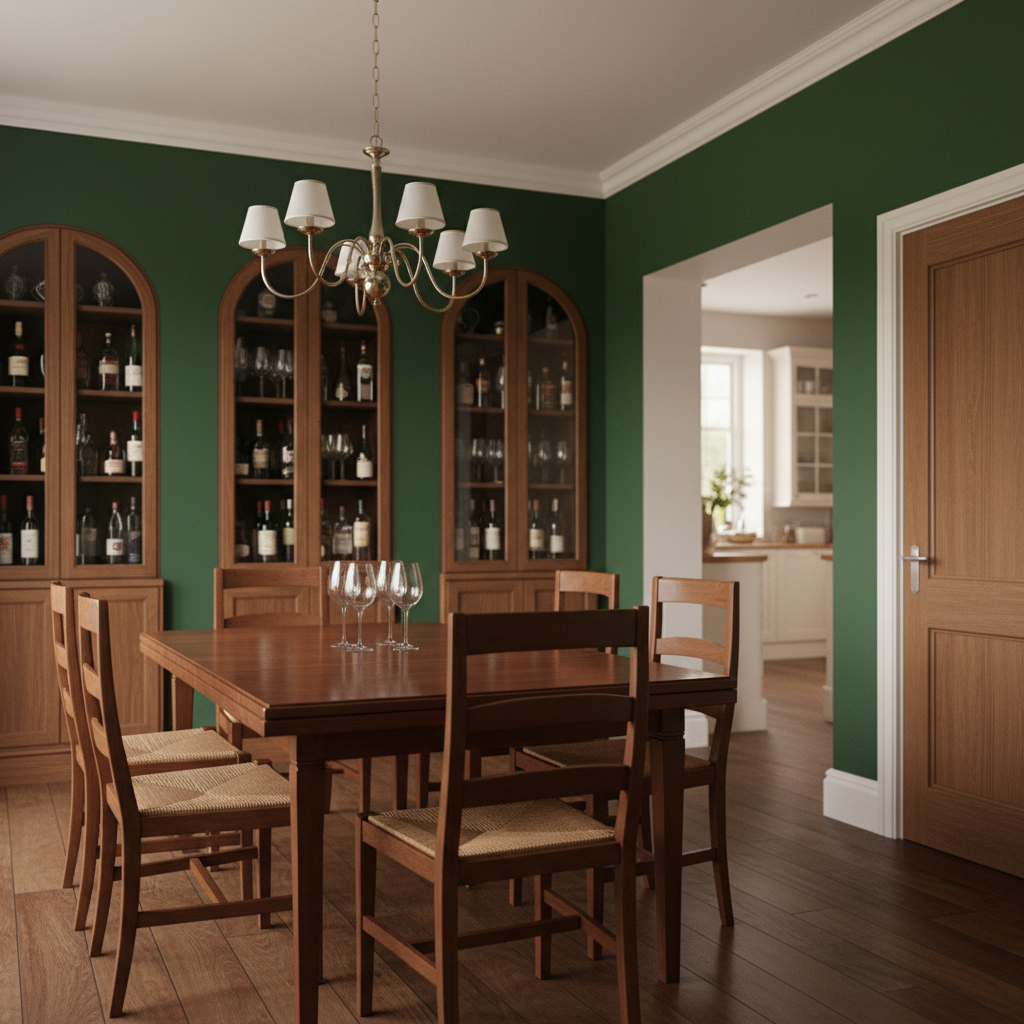Emerald Wood Classic Dining Room Interior Design
Design Analysis
What Lasts
The solid-wood construction ages well: hardwood resists dents better than softwood, and natural patina often improves the look over years. Joinery and a thick tabletop mean the table can survive heavy use and occasional refinishing.
What to Watch Out For
Watch for water rings, heat marks and long-term finish wear at the edges. Heavy or uneven loads can stress joints; if the base isn’t reinforced, wobble can develop with age.
Care Tip
Use coasters and trivets; wipe spills immediately with a damp cloth. Reapply a suitable furniture oil or finish every few years and check/tighten fasteners seasonally to prevent wobble.
What Lasts
Chair frames are durable if made from hardwood; the simple form tolerates refinishing. The woven seats are comfortable and offer good breathability, often lasting many seasons if not abused.
What to Watch Out For
Woven seats can sag, fray, or break under concentrated wear, and they’re vulnerable to spills and pets. Joints between seat and frame are common points for loosening over time.
Care Tip
Rotate chairs periodically, avoid sitting on chair backs, and clean spills promptly. Vacuum woven seats gently and tighten loose joints; replace or reweave seats when fibers begin to fail.
What Lasts
Properly built cabinetry is long-lived: hardwood frames, glass doors, and fixed shelving provide decades of service. Glass protects contents from dust while the structure stabilizes the wall.
What to Watch Out For
Shelves overloaded with heavy bottles can bow; glass doors and hardware may loosen. If cabinets are inset into the wall without adequate ventilation, trapped humidity can affect stored items and finishes.
Care Tip
Distribute weight evenly, avoid overloading shelves, and check hinges periodically. Wipe glass with non-abrasive cleaner and dust wooden interiors; maintain moderate humidity to protect wood and stored labels.
What Lasts
Brass hardware holds up well and develops an attractive mellow patina; quality wiring and sockets last many years if correctly installed. Shades diffuse light and are easy to replace if faded.
What to Watch Out For
Fabric shades can yellow or collect dust; brass can tarnish in humid conditions. Incorrectly mounted fixtures may sag, and bulbs that generate heat can affect nearby finishes.
Care Tip
Turn power off before cleaning. Dust shades and brass regularly; use a mild brass cleaner sparingly. Replace bulbs with lower-heat LED equivalents and check mounting hardware annually.
What Lasts
Solid hardwood floors are one of the longest-lasting elements: they can be sanded and refinished multiple times to remove dents and scratches, effectively renewing the surface.
What to Watch Out For
Scratches from chair legs, moisture from spills, and high-traffic wear will show over time. Gaps can appear with seasonal humidity changes if installation or acclimation was poor.
Care Tip
Use felt pads under chair legs and an area rug under the table if needed. Clean with manufacturer-recommended products, wipe spills quickly, and refinish when surface scratches are extensive.
What Lasts
Good-quality paint resists fading and scrubbing; a rich color lends immediate personality and hides minor imperfections better than pale tones.
What to Watch Out For
Sunlight over time can fade or shift color. Scuffs, chair-back rubs, and kitchen traffic near the doorway can mark the paint. Dark colors can reveal dust and dings more starkly in some lights.
Care Tip
Choose a durable, washable finish (e.g., eggshell or satin) and touch up high-impact areas periodically. Keep curtains or UV film on nearby windows to limit sun fade and clean marks gently with a damp cloth.
What Lasts
Painted moldings are durable architectural details that hide small gaps and make finishes look intentional; they’re easy to repaint when styles shift.
What to Watch Out For
Trim can chip or scuff from furniture and doors; joints may separate slightly with seasonal expansion and contraction.
Care Tip
Keep touch-up paint on hand for nicks. Clean with mild soap and water; recaulk or re-nail loose sections as humidity cycles cause shrinkage or separation.
What Lasts
A solid wood or well-built engineered door is resilient and provides long-term privacy and insulation value. Hardware can be serviced or replaced independently.
What to Watch Out For
Door edges and bottoms can scuff from traffic; humidity shifts may cause sticking or warping. Handles and latches wear with heavy use.
Care Tip
Lubricate hinges and handles occasionally. Refinish or touch-up exposed edges and adjust strike plates if the door begins to stick in damp seasons.
What Lasts
Good-quality glassware can last for many years if handled with care; it’s versatile for everyday and special occasions.
What to Watch Out For
Stemmed glassware is fragile — prone to chips, cracks and tipping. Hard knocks during service or cleaning can break pieces.
Care Tip
Store glasses upright in a secure cabinet, hand-wash delicate stems or use a dishwasher’s gentle cycle with secure placement, and avoid sudden temperature shocks.
What Lasts
An open plan connection is a durable functional choice: it supports traffic patterns and keeps spaces visually linked over the long term.
What to Watch Out For
High-traffic zones pick up scuffs on walls and floors; proximity to the kitchen increases risk of splashes, grease, and noise transfer.
Care Tip
Protect nearby walls with easy-to-clean paint or a narrow chair rail; place a runner or mat in the threshold to catch spills and reduce wear.
AI Design Assistant Available
Get expert design advice! Mention @DesignerAI in your comments or replies to get personalized design recommendations based on this design.
💡 Examples:
- • "@DesignerAI what colors would work best for a smaller space?"
- • "@DesignerAI how much would this cost to implement?"
- • "@DesignerAI suggest budget-friendly alternatives"
Comments
(0)Please log in to add comments and get AI responses
No comments yet. Be the first to comment!
Loading related designs...
